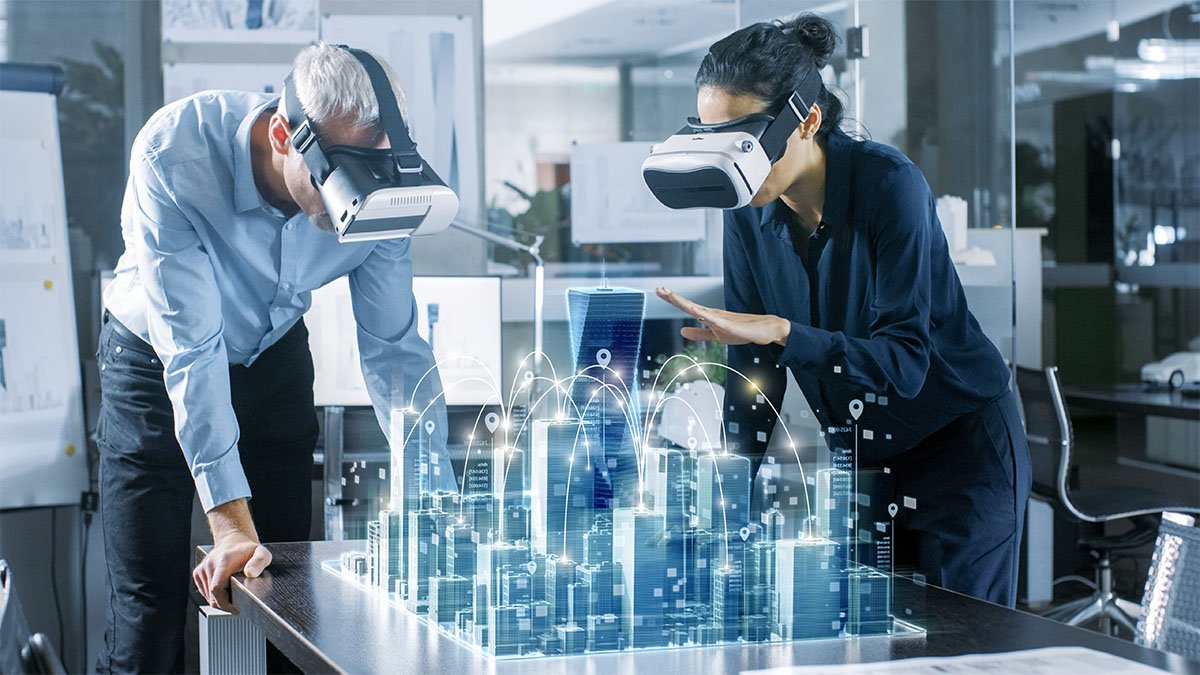According to Statista, the augmented and virtual reality market is expected to expand drastically exceeding 192 billion US dollars by 2022. (Source)
Today, customer experience is the king and digital transformation is the driving force.
We are living in the age of technology where everything is undergoing digital transformation. Businesses highly depend on technology to take important decisions and provide personalized customer experience, which ultimately is the key to success. Technology has become an integral part of our daily lives. And rapidly growing emerging technologies such as Augmented Reality (AR) and Virtual Reality (VR) have changed the way we interact with our surrounding environment as well as technology devices.
The ability to implicate digitally created objects in a real-world environment or complete immersion experience while shutting out the physical world has transformed all the industries, including entertainment, e-commerce, gaming, education, and even healthcare. If you are yet to explore AR and VR technologies-based solutions to grow your business, it is time that you take a deep dive in AR and VR to grow along with the fast-growing technology world.
Many companies around the world have started developing AR and VR based applications to deliver an advanced user experience to their customers. However, still many of the AR/VR development companies, as well as, AR/VR developers face challenges in selecting the right tool for developing the AR/VR apps.
Determining which AR/VR SDK (Software Development Kit) or tool to utilize to build the AR/VR based solution completely depends on whether you want to develop mobile apps or game, marker-based apps or location-based apps, etc. If you are not aware of all the available tools in the market, you might end up investing in the wrong tool, which might not give the desired or suitable outcome. To ease the work, we have created a comprehensive list of the top AR and VR development tools and SDKs that can help you build the required solution.
Top 21 Augmented Reality SDKs-

1. Apple ARKit
Having been introduced with iOS 11 during the Apple’s Worldwide Developers Conference in June 2017, ARKit became a historic announcement. ARKit can be used to create applications for iPhone and iPad considering they have an A9 processor or above. It allows developers to design and develop applications that extend unique customer experience through multiple features such as-
- 2D image detection and tracking
- 3D objects recognition and placement
- Horizontal and vertical planes detection
- Facial tracking
- Stable and fast motion tracking
- Scale estimation
URL: https://developer.apple.com/arkit/
2. Vuforia
Vuforia is one of the most popular SDKs to develop Augmented Reality Applications that enable businesses to provide an immersive AR experience to their customers. Due to the availability of the APIs via Unity, Vuforia can be utilized to develop native apps for iOS as well as Android. It is also considered a comprehensive SDK with an extensive range of features for AR apps.
- Identification and tracking of image targets, English texts and 3D objects in real-time
- Placement of virtual objects such as 3D models in a real-world environment
- 3D multi-target configurations
- Virtual buttons
- Localized occlusion detection using virtual buttons
URL: https://developer.vuforia.com/
3. Wikitude
To develop a location-centric augmented reality experience, Wikitude is used to develop AR mobile apps and prototypes. The new Wikitude SDK allows developers to implement geolocation features, along with image tracking and object recognition. It is also known for its flexibility to develop unique customer-centric mobile applications in the shortest period. Some of its features include:
- 3D recognition and tracking
- Image recognition and tracking
- Cloud recognition
- Location-based AR
- Video overlay
- Smart glasses integration
- Integration with external plugins
URL: https://www.wikitude.com/
4. Kudan
Kudan is considered to be a one-stop-shop for AR application development. It is one of the handiest and fastest AR tools in which data, size, speed, and sensitivity can be controlled by the projects and requirements. It works by adding a layer on objects to recognize them, however, it doesn’t offer much for face detection.
- Marker-based as well as markerless location and tracking requirements
- Image recognition
- Visual-SLAM
- Sensor fusion
- Algorithm fusion
- Flexible integration
- Versatile customization
5. MaxST
MaxST is a comprehensive platform that ensures speedy and easy AR app development process. It comes with two SDKs, 2D SDK for image recognition and 3D SDK for environment recognition Its multiple features and environments enable developers to build AR applications quickly and easily.
- Instant tracking
- Identification of horizontal/vertical planes
- Visual Simultaneous Location and Mapping to create a ‘virtual map’ for tracking the environment or the surrounding area
- Object tracking, image tracking, and multi-target tracking
- QR/barcode scanning
- Unity plugin integration
URL: http://maxst.com/
6. Google ARCore
Google ARCore is one of the most used and popular SDK to build apps for smartphones and tablets. Surprisingly, it is quite flexible that its AR apps are not only supported on Android but also on iOS-based devices while allowing developers to develop cross-platform AR applications. It is based on two elements, position tracking, and object recognition. Some of its prominent features include,
- Light estimation as per the real-world conditions
- Accurate placement of virtual objects
- Light tracking to create realistic objects
- Detection of the size and location of vertical, horizontal and angled surfaces
- Motion tracking as per the phone’s position
URL: https://developers.google.com/ar/
7. EasyAR
EasyAR is a free AR development tool, which supports major mobile development platforms. Its SDK enables businesses and developers to develop an extended immersive AR experience through mobile applications. EasyAR also comes with a pro version that is a paid version of the tool and supports extra features. Developers can utilize its features depending upon their packages.
- Easy AR Basic: Developers can manage workflow, enhance APIs, ensure compatibility, video playback, QR code scanning, and comprehensive unity integration.
- EasyAR Pro: Developers can implement additional features such as 3D object tracking, planer image tracking, screen recording, content recording solution, simultaneous detection, and tracking of multiple types of targets.
8. ARToolKit
ASRToolKit is an open-source SDK that offers multiple complex features to build AR apps and smart glasses efficiently and quickly. It offers a compiled SDKs for iOS, Android, Windows, Mac OS, and Linux platforms. It is one of the first AR SDKs with an easy-to-use interface and fast turnaround time. Its multiple features include:
- GPS and compass integration
- Unity3D and OpenSceneGraph Support
- 2D recognition
- Simultaneous tracking Single and dual camera support Additional elements mapping through OpenGL
- Integration with smart glasses
- Supports multiple languages
URL: https://github.com/artoolkit
9. Onirix
Develop, host and publish your AR-enabled mobile app with Onirix without writing codes. Onirix SDK interacts with smartphones and tablets while utilizing a cloud-based platform to provide an immersive AR experience to users. It allows developers to ‘develop once and deploy on multiple platforms’. Its API allows usage of existing data to build new AR apps with enhanced features and experience. Its consistent updates are like a cherry on the top.
- Unity3D support for rendering
- Cloud integration
- Launch Pad for publishing on social and web platforms
- Friction-free scenes
10. Pikkart AR SDK
The Pikkart SDK allows developers to create unique and feature-rich AR apps that are user-friendly, reliable, scalable, robust and most importantly significantly inexpensive. It offers easy and quick application development process along with scalability.
- Image recognition
- Geo augmented marker
- Cloud recognition with API
- AR Logo
URL: https://developer.pikkart.com/augmented-reality/sdk/

11. DeepAR
DeepAR was created to develop high quality fully optimized 3D lenses, 3D Face masks, filters and special effects as offered by Snapchat for mobile, web and game development. It utilizes deep learning and neural network models. Among many features, there are-
- Facial detection feature
- Accurate and quick facial detection
- Ability to detect over 68 facial feature points at nearly 60 frames per second
- Detection of multiple faces in real-time
- Real-time emotion detection
- Multiple face detection
- Real-time face tracking
12. MixedReality Toolkit (HoloLens)
The MixedReality Toolkit is utilized to quicken the development of process augmented reality applications build for Microsoft HoloLens and other Windows-based Mixed Reality headsets. Some of its supported devices include,
- Microsoft HoloLens
- Microsoft Immersive Headsets (IHMD)
- Steam VR (HTC Vive / Oculus Rift)
- OpenXR platforms
Some of its features include:
- Input System
- Articulated Hands and Gestures
- Eye Tracking
- Voice Commanding
- Controller Visualization
- Teleportation
- UI Controls and Diagnostic Tool
URL: https://microsoft.github.io/MixedRealityToolkit-Unity/
13. Xzimg
Xzimg is a software for image processing and face recognition for augmented reality-based objects. There are multiple Xzimg products like Augmented Face solution, Augmented Vision solution, and Magic Face that offer real-time face recognition, image tracking, and deformable face tracking features respectively to help in the creation of AR-based applications. The applications can be developed for a desktop, mobile, web browser or via the Unity plugin. The key features include:
- 2D and 3D recognition
- Marker recognition and tracking
- Face recognition in videos
- Face tracking and face replacement
14. DroidAR
DroidAR is an opensource framework to create AR applications only for Android. You can build a location-based Augmented reality as well as a marker-based augmented reality applications with the help of Droid AR. One can develop and test the applications of the desktop which helps in quickening the development cycle. The features include:
- Footstep recognition
- Indoor AR
- Location-based gaming
- Crowdsourcing Framework
- Step detection for location accuracy
- Combination of location and vision-based AR
URL: https://bitstars.github.io/droidar/
15. AR.js
AR.js is a JavaScript-based opensource AR SDK. It is an efficient Augmented Reality solution to build an application on the browser. Since it runs on your web browser, there no need to install an application. However, it runs on all the mobile platforms including Android, iOS 11 and Windows mobile.
- Augmented Reality content on the web
- Customizable AR objects
- Ease of access and faster development
URL: https://github.com/jeromeetienne/AR.js/blob/master/README.md
16. HP Reveal Studio
HP Reveal Studio enables users to easily create and manage immersive augmented experiences without any requirement of creating code. It is a cloud-based augmented reality platform available for Android as well as iOS. Its key features include:
- Intuitive and easy-to-use interface
- Personalized Augmented Reality option
- Ability to embedded with new as well as existing applications
- Applicable for sales and marketing purpose for which insights and growth can be tracked
URL: https://www.hpreveal.com/
17. BlippBuilder
BlippBuilder is an AR creation tool that helps in creating augmented reality campaigns. You can design and drive campaigns to attract your users with this simplest augmented reality solution. Without any coding, you can transform your packaging, advertisements, magazines, posters, and more. BlippBuilder increases your efficiency in your Augmented Reality project by providing the following features:
- Access to the library of assets, templates, and widgets
- Drag and drop interface availability
- One-click publishing to iOS and Android apps
- Tracking and analysis of results on a data dashboard
- Live updates to enhance AR experience
- Creation of templates for faster production
URL: https://www.blippar.com/build-ar
18. AugMara CMS
AugMara CMS is an Augmented Reality Content Management System that helps in turning print content into multimedia and online content that is attracting to the users. It assists in building an augmented reality-based content that provides an interactive and dynamic user experience. Here’s how AugMara CMS can be used for:
- Retail: Integrating AR content to the printed information such as catalogs by adding videos, 3D models, weblinks, image galleries, registration forms, and much more.
- Advertisements: Enriching printed content with mini-games, videos, 3D models, etc., that can help engage users and increase their interaction with the brand.
- Direct Marketing: Communicating through multimedia content and personalized video content.
- Shopping experience-: Developing 3D models and animation of the products.
- Construction: Visualizing building and architecture
19. Amazon Sumerian
Amazon Sumerian is used to create and run VR, AR and 3D applications that are easy and quick to develop. You can easily build highly immersive and interactive scenes without any additional skills such as specialized programming and 3D graphics expertise. Its supported platforms include Oculus Go, Oculus Rift, HTC Vive, HTC Vive Pro, Google Daydream, and Lenovo Mirage as well as Android and iOS mobile devices.
- Creation of 3D objects
- Development of a virtual environment
- Development of lifelike characters
- Support for multiple platforms
URL: https://aws.amazon.com/sumerian/
20. Augmented Pro
Augmented Pro simplifies industrial operations with a high-end augmented reality software that helps you with maintenance, production, and inspection tasks. You can create your industrial procedures for learning and support on the operational ground. There are two Augmented Pro solutions.
- Augmented Pro Creator: Helps create your task lists with AR content, without coding.
- Augmented Pro Player: Plays your task lists with AR content on Windows, Android or iOS.
URL: https://www.augmentedpro.com/
21. Augment
Augment is a SAAs-based Augmented Reality platform that is used for product visualization. It helps in building mobile augmented reality solutions for e-commerce, field sales, education and more. Augment helps provide 3D content and an optimized AR experience to your customers. With Augment, you can deliver interactive and unique solutions such as:
- Increase eCommerce sales and engagement
- Drive field sales
- 3D products for e-commerce
Top 13 Virtual Reality SDKs


1. Unity 3D
Unity 3D is a VR development tool created for professionals as well as beginners. However, beginners can get started easily and efficiently by creating the best quality Virtual Reality applications and games since it offers a huge asset store to find 2D, 3D, SDKs, and templates to directly import in the development environment. Developers can find the characters from the Unity asset to save time and efforts of developing games from scratch. Unity has a large community where developers help one another with their problems and queries, which enables them to increase the quality of the games along with quickening the game development process. To increase efficiency, one can look at best practices, training sessions as well as tutorials to build virtual reality games efficiently.
Unity 3D is a strong platform that believes in empowering developers with all they need to create, operate and monetize. Their offerings for various industries like gaming, automotive, transport, manufacturing, film, animation cinematics, architecture, engineering, and construction include,
Tools to build gaming solutions such as mobile games, instant games, AR and VR games and console and PC games
- Create high visual fidelity, 3D real-time interactive customer experiences
- Produce realistic real-time 3D images and videos
- Design and re-engineer vehicles in VR
- Provide a real-time customer experience before the vehicle exists
- Develop interactive 3D environments for architecture
- Develop virtual showrooms, immersive 3D space, and data visualization
Supported platforms include:
- Major Head Mounted Display (HMD) devices, including Oculus Rift, Steam VR/Vive, Play station VR, Gear VR, Microsoft HoloLens, and Google’s Daydream View
- Mobile platforms including Mac OS X, Android, iOS, Window
- The paid version supports Nintendo Wii, Xbox 360, and PlayStation.
URL: https://unity.com/
2. Unreal Engine 4
Unreal Engine 4 is one of the most popular SDKs among professionals to build games with excellent graphics and advanced yet realistic features. Lifelike features, smooth navigation, advanced lightning, improved cinematic system, and modern editing environment enable developers to build an excellent quality game that is user-friendly and unique. It also comes with an asset store that offers animations, plugins, blueprints, props, live training, and documentation to guide you through game development. Unreal Engine 4 offers:
- An advanced cinematic, post-processing, and PBR (physically based rendering) capabilities
- Low friction startup and rapid iterations
- Frequent updates for software and hardware
Supported platforms include:
Various HMDs such as Oculus Rift, HTC Vive, Samsung Gear VR, Google VR, and Leap Motion, etc.
Windows PC, PlayStation 4, Xbox One, Mac OS X, iOS, Android, AR, VR, Linux, HTML5 etc.
URL: https://www.unrealengine.com/en-US/vr
3. Blender
Based on Python, Blender is a modern and opensource 3D graphics software that supports and assists developers throughout the 3D process from rigging, animation, simulation, rendering, motion tracking, video editing, to complete game creation. Blender has a solid developers community and offers workshops, tutorials along with add-ons such as CAVE/VideoWall, Head-Mounted Displays (HMD) and external rendering modality engines for 3D modeling and interactive game development The offerings include,
- Ultra-realistic rendering with Cycles Render Engine
- VFX, animation, and story-art
- Real-time viewport preview
- HDR lighting support
- VR rendering support
Blender is supported on Windows, Mac OS, and Linux platforms.
4. Amazon Lumberyard
Amazon Lumberyard is a cross-platform virtual reality game creation tool that fastens the process of game development along with ensuring high-quality games. One can create their template and use them to build new Lumberyard Gems, containing templates to build their games. It is among the few tools that support all the VR devices without the requirements of editing the engine code. While enabling developers to connect their games to the AWS cloud, it also allows them to interact with their fans on Twitch.
Amazon Lumberyard is supported on the following platforms.
- Major HMDs
- PC, Xbox One, PlayStation 4, iOS, Android (Nexus 5 and equivalents with support for OpenGL 3.0+).
- Few servers on Windows and Linux
URL: https://aws.amazon.com/lumberyard/
5. CryEngine
CryEngine is considered as the best virtual reality SDK that has built-in 3D rendering optimization tools. It minimizes the downtime of the processes of animated objects visualization and comes with easier business logic execution and a new particle system that allows rendering load at GPU in real-time.
CryEngine offers a variety of tools across different domains and ensures the following:
- Powerful 3D modeling, scripts, sounds, animations, and many more
- Built-in 3D rendering optimization tools
- Advanced Volumetric Cloud System
- FMOD Studio and DirectX 12 support
Its supported platforms include Windows, Linux, PlayStation 4, Xbox One, Oculus Rift, OSVR, PSVR, and HTC Vive.
URL: https://www.cryengine.com/
6. AppGameKit
AppGameKit is the best tool to practice building a Virtual Reality app to master the art of development of the VR games. With a simple game idea, you can not only build a game quickly but also learn and acquire enough experience to take the next step and create even more complex games based on VR. It provides development control for SteamVR supported head-mounted displays, touch devices, and Leap Motion hand tracking.
- 60 VR commands
- Comes with AGKs BASIC scripting system
- Supports the creation of standing or seated VR experiences
- 3D scene rendering to HMD
Supported platforms include Windows, Mac, Linux, iOS, Android including inc Google, Amazon & Ouya, HTML5, Raspberry Pi (free from TGC website).
URL: https://www.appgamekit.com/
7. Oculus Medium 2.0
Oculus Medium allows sculpting, modeling, painting, and creating objects for the virtual reality world app development that ultimately helps in character making process. It helps in the creation of various 3D objects with the help of Oculus Touch Controllers and the Oculus Rift. Oculus Medium 2.0 uses Vulkan, a rendering engine, that ensures smoother frames, high resolution sculpts and better memory management. Its comprehensive features include the following:
- Grid Snapping
- Increased layer limit
- Multiple lights
- 300 prefabricated stamps
It is supported on Windows 7 & 8.1.
URL: https://www.oculus.com/medium/
8. Google SketchUp
Google SketchUp is a primary level application for beginners to create simple 3D modeling computer programs for a wide range of drawing applications including architecture, interior design, landscape architecture, civil and mechanical engineering, as well as film and video game design. It contains basic 3D modeling concepts that help developers learn and build CR game apps faster along with great learning experiences. It offers features including Interoperability, Extensibility, Components, Customization, Generate Reports and Inferencing.
Its supported platforms include Windows 7 and newer and OS X 10.9 and newer.
URL: https://www.sketchup.com/
9. Tilt Brush
Tilt Brush is another efficient tool of Google that is often used to build VR applications to paint in 3D space with virtual reality. It allows developers to draw animated characters, build houses, and design interiors in real-time. Looking at the potential of Tilt Brush, it is believed to be expanding the scope of VR based applications. It is known for its user-friendly and intuitive interface and poly integration. It is supported on Windows 7 SP1, Windows 8.1 or later, Windows 10.
URL: https://www.tiltbrush.com/
10. Vizor.io
Vizor, a visual environment is a web-based 3D editing and prototyping tool with visual scripting that is utilized to create 360-degree stories. Its features are below:
Visual programming editor to create WebVR and WebGL experiences
- Live preview
- Data flow visualization
- Network communication
- Unlimited undo
11. JanusVR
Traditional in nature, JanusVR is used to view a 3D version of the website. There are many similarities between the virtual environment creation and web browser creation. Hence, Janus is more like a web browser than a development tool used to create VR applications. The developer can use an HTML-like syntax to set up “rooms”. One can operate traditional websites, 2D and 3D environments, websites, and pages, etc. The supported platform is Windows 7 or a newer version.
- Works on HTML-like syntax
- Built-in multi-user support
- Low learning curve
URL: http://janusvr.com/
12. React 360
React 360 is a framework used to create 3D, 2D and VR interfaces for building photo and video viewers, 360 tours, adventure games, 3D board games, etc. The aim is to create an immersive engaging experience for the users. Since it is built to be seen on a modern web browser, it has the potential to reach billions of mobile and computer users. The React library is specifically created to simplify the creation process of complex UI. Key features of React 360 include,
- Excellent and high-quality user interface
- Rich multimedia experience
- Creation of 2D and 3D interface
URL: https://facebook.github.io/react-360/
13. A-Frame
A-frame is a web framework that is used to build immersive virtual reality experiences. A-frame allows you to create 360 images, add 3D objects and videos, as well as create a 3D environment along with mix and match. The additional benefits of using A-Frame includes,
- Allows testing projects in Glitch easily
- Uses the frame’s built-in inspector
- Comes with an open-source architecture
- Provides interface that is easier to build especially for beginners
URL: https://aframe.io/
Conclusion
AR and VR technologies have a very promising future and potential to transform all the industries by taking the customer experience to higher levels. Are you ready to explore and grow exponentially along with the AR and VR technologies? Would you like to leverage AR/VR to increase commercial opportunities significantly?
At Blue Whale Apps, we can build you an impressive AR based technology solutions that can unleash growth in your business irrespective of your industry. For more information, get in touch with us.






